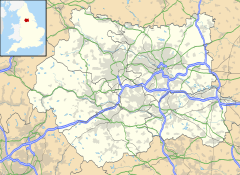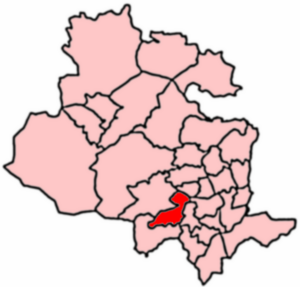Clayton, West Yorkshire facts for kids
Quick facts for kids Clayton |
|
|---|---|
| Population | 16,982 (2011 census) |
| OS grid reference | SE123317 |
| Civil parish |
|
| Metropolitan borough | |
| Metropolitan county | |
| Region | |
| Country | England |
| Sovereign state | United Kingdom |
| Post town | BRADFORD |
| Postcode district | BD14 |
| Dialling code | 01274 |
| Police | West Yorkshire |
| Fire | West Yorkshire |
| Ambulance | Yorkshire |
| EU Parliament | Yorkshire and the Humber |
| UK Parliament |
|
| Councillors | |
Clayton, also known as Clayton Village, is a lively place in West Yorkshire, England. It's part of the City of Bradford and is located about 3 miles west of Bradford city centre. Clayton is very old, even mentioned in the Domesday Book from the 11th century! This means it has been around for at least 900 years. It was known for its clay, which is how it got its name.
Later, Clayton became important for the wool trade. It was once home to the main office of the British Wool Marketing Board. Today, the village has a main street called Clayton Lane. Here you'll find traditional pubs and shops. There are also churches, a golf club, and a reservoir nearby at Clayton Heights. This area is now a Country Park, offering great views of Bradford and the village of Thornton. In 2004, Clayton got its own parish council again, helping to manage the village.
Contents
History of Clayton Village
Clayton has a long and interesting past. People lived here even before recorded history. In 1951, a stone axe from the Neolithic period (New Stone Age) was found in Thornlea Grove. This axe is now kept at the Cartwright Hall Museum.
The village was officially recorded in the Domesday Book in 1086. It was called "Claitone" back then. This name likely comes from old words meaning "farmstead on clay." For many centuries, from 1160 to 1866, Clayton was privately owned. After that, a local board was created to help manage the village.
In the 1870s, a spot called "the wells" in the village centre was used for outdoor speeches. Clayton used to be a separate area called a "township." It became its own civil parish in 1866. Later, in 1930, Clayton became part of the larger County Borough of Bradford. In 2004, the village once again gained its own civil parish status with a local council.
How Clayton is Governed
Clayton is part of the Clayton and Fairweather Green area. This area is represented on the City of Bradford Metropolitan District Council.
Clayton Parish Council
In 2004, Clayton got its own civil parish council. This council helps manage local issues. In 2007, the council officially called Clayton an "urban village."
The parish council helps with many things:
- It listens to problems and ideas from local residents.
- It works with the main Bradford Council to make sure services are good.
- It gives opinions on new building plans.
- It manages the village's allotment gardens.
- It offers grants to local community groups.
The Clayton Parish Council has 13 councillors. They are led by a Chairman and a Vice-Chairman, who are chosen every May.
City Council Representatives
The Clayton and Fairweather Green area has three councillors on the City of Bradford Metropolitan District Council. These councillors are Sinead Engel, Carol Thirkill, and Michelle Swallow, all from the Labour Party.
Geography and Landscape
Clayton is located about 720 feet above sea level. It sits on a fairly flat area of land, with the Clayton Beck valley dropping steeply below it. The land also rises steeply to the south, south-east, and south-west. The soil in Clayton is mostly clay, but you can also find sandstone and gritstone.
The village is three miles from Bradford city centre. The village of Thornton is across the valley, and Queensbury is further up the hill from Clayton. Clayton Beck flows through the bottom of the valley.
The centre of Clayton village was made a special "conservation area" in 1977. This helps protect its historic character. The main street, Clayton Lane, runs next to the park. It has several traditional pubs like the Fleece, the Royal Hotel, the Albion, and the Black Bull. The Black Bull is the oldest pub in the area. These pubs have been important to village life for a long time. For example, an old newspaper from 1861 mentioned how popular the pubs were when a famous circus owner, Pablo Fanque, visited.
Clayton also has several shops, churches, a golf club, and a country park called Thornton View. From here, you can see great views of Bradford and Thornton.
Population of Clayton
According to the 2011 Census, 16,982 people lived in the Clayton and Fairweather Green area.
| Clayton population 1831-1971 |
|||
|---|---|---|---|
| Year | Population | ||
| 1831 | 3,609 | ||
| 1891 | 7,484 | ||
| 1901 | 5,119 | ||
| 1911 | 4,863 | ||
| 1921 | 5,043 | ||
| 1931 | 5,491 | ||
| 1951 | 7,103 | ||
| 1971 | 14,332 | ||
| Data for Clayton parish from UK Census results |
|||
Getting Around Clayton
Clayton is part of the West Yorkshire Metro transport network. There isn't a train station in Clayton, but there are two regular bus routes that serve the village. These buses are run by First West Yorkshire.
The 636 and 637 bus services follow the same route out of Bradford until they reach Clayton. Buses run frequently during the day, starting early in the morning and continuing until late at night on weekdays and Saturdays. On Sundays, the services are less frequent.
Schools in Clayton
Clayton has four schools. Three of them are state primary schools:
- Clayton St. John's Church of England Primary School
- Clayton Village Primary School
- St. Anthony's Roman Catholic Primary School
The very first school in Clayton was built in 1819. St. Anthony's Primary School opened in 1954 and is named after the local Catholic Church. A school for Muslim girls, Jaamiatul Imaam Muhammad Zakaria School, recently opened in the old Thornton View Hospital buildings.
Places of Worship
Clayton has several Christian churches from different denominations. These churches work together on a "Churches Together" committee. They organize events like visits to a nursing home, a "walk of witness" on Good Friday, and carol singing at Christmas. The churches also host many activities like groups for parents and toddlers, youth clubs, and meals for senior citizens.
- The Anglican parish church is dedicated to St John the Baptist and opened in 1851. It has a new extension for church activities, art classes, and Scouts.
- The independent Clayton Gospel Hall opened in 1928. It is home to West Yorkshire's only highland dance and piping group.
- Clayton Baptist Church opened in 1984, replacing an older building.
- The village also has a Methodist church on Clayton Lane, known for its monthly coffee mornings.
- St Anthony's Roman Catholic church is linked to the Catholic primary school.
Sports in Clayton
Clayton is home to amateur sports teams in football, rugby, cricket, and bowls.
- Clayton Albion F.C. is the local football team. They started in 2018 and quickly won their division and a cup in their first season.
- Clayton Rugby League Club plays in burgundy and amber striped kits at home. They have a strong history, winning several championships and cups. The club has teams for different age groups, including those under sixteen.
- Clayton Cricket Club has two senior teams and four junior teams (Under 9s, 13s, 15s, and 17s) that play in the Halifax Cricket League.
- Mayfield Cricket Club also has two senior teams and is working to start a junior team. They play in the Bradford Mutual Sunday School Cricket League.
- Clayton Golf Club manages a nine-hole golf course at Thornton View Road. The club was founded in 1906 and is for members only.
Community Facilities
Clayton has several places for the community to use:
- Clayton Library is in the original village school building on Clayton Lane. It offers free computer and Internet access.
- The village hall on Reva Syke Road serves tea and coffee every weekday morning. It can also be hired for events and hosts many weekly groups.
- The Thornaby Hub on Thornaby Drive is home to the Clayton Estate Community Action Group and a food bank called 'Grub at The Hub'.
You can also find a butcher's shop (Taplin's) and other businesses in the Green End area of Clayton Village.
Famous People from Clayton
- Albert Pierrepoint was born and lived in Clayton. He was a well-known executioner in Great Britain until 1956. His father, Henry Albert Pierrepoint, also born in Clayton, was an executioner too.
- Abe Waddington was born in Clayton in 1893. He was a bowler for the English cricket team from 1920 to 1921.
Images for kids






